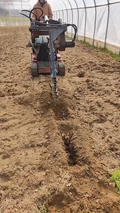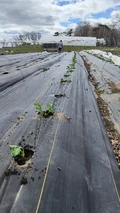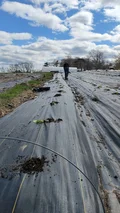TL;DR
Beautiful weather for planting today. Six rows of dinosaur kale, red kale, and swiss chard into black fabric covered field.
Keeping the Greenhouse Watered
The greenhouse is full of well-off scallions, onions, lettuces, kales, chard, chois and early starts of peppers, tomatoes, and various herbs. Even in April, this healthy situation doesn’t last long without plenty of watering. This morning I spent about 45 minutes carefully watering everything…the more mature starts with the shower setting and smaller or not yet germinated seeds with the mist setting. There are tray types for just about every stage of growing.
Even with the overcast day we had, I was asked to go back and spot water anything that looked dry. This included the row channel trays on the heat mats as well as anything in a paper pot (peppers) for inclusion in a future CSA share. The greenhouse stays very humid and between 70-80 Farenheit.
Testing Out the Trencher in the New Greenhouse
After I was done watering, we rode to gather some rebar to use as line-measuring poles in the new greenhouse setup for upcoming tomatoes. I pounded in the rebar in predetermined locations on both (door) ends) inside the greenhouse so that we could tie twine between them all the length down as guidelines for trenches. Then we sprinkled cheap baking flower over the lines and moved the twine from pole to pole and sprinkled until three pairs of two trench markings were down.
The trencher (TRX-250 Walk-Behind) looks like a chainsaw on steroids. You stand on the back of the engine part, lower the chainsaw digging part to the desired depth, and drive backward while it chews up the soil to make a 2-3 inch trench, in our case about 4-6 inches deep. This is where the tomatoes will be planted all the way down, trained up twine hanging from the cross-bars as most greenhouse tomatoes are grown.
This machine is also used to dig trenches for the electrical conduit being laid to support the greenhouse power needs, such as the air compressor to create a bubble of air between two poly sheet layers over the greenhouse…making it act like insulation and keeping it just tight enough to the form to resist wind gusts.
Planting, Take One: Dinosaur Kale
Once the greenhouse assistance was done, we loaded up the big trick with about 25 trays of various kales and chard. Before lunch break, we got about two rows of dinosaur kale planted into fabric holes which were already cultivated on Monday. As we were doing that, some other helping hands cultivated rows 3 and 4 in prep for red kale.
Lunch
Lunch was sauté of chicken breast, onions, and cheese. Had it on rolls with mayo and pickles. Easy, brilliant. Helps with the look-ahead to an afternoon of field work.
Planting, Take Two: Red Kale and Chard
After lunch we planted the red kale, then we cultivated the last two rows before dropping and planting the chard into them. This all took the rest of the afternoon, a little less than 4 hours.
The Summary from an LLM’s Perspective
Main Themes:
- Farm work and daily routine
- Greenhouse management (watering, misting, seedling care)
- New greenhouse setup and installation (trenches, rebar, soil preparation)
Activities:
- Watered established root plants in the greenhouse
- Watered seedling trays on heat mats with a mist setting
- Set up trenches for tomatoes
- Marked trench locations with string and flower lines
- Tested out the trench digger machine
- Loaded kale and chard onto a truck and transported to the field
- Dug holes in the field for kale and chard seedlings
- Planted kale and chard seedlings in the holes
- Did field cleanup and brought unused seedlings back to the greenhouse
New Things Not Yet Encountered:
- The trench digger machine (a new tool used for digging trenches)
- Specific spacing and depth requirements for tomatoes (not mentioned in previous notes)
Questions and Future Areas of Research:
- How to improve efficiency and productivity in workdays
- Optimal spacing and depth requirements for tomatoes in this particular greenhouse environment
Suggestions:
- More detailed guidance on specific tasks, such as trenching and greenhouse management
- Additional training on the trench digger machine for safety and effectiveness
- Exploration of ways to streamline processes or eliminate unnecessary steps
- Further research on optimal tomato spacing and depth requirements
[end of post]
Enjoy Reading This Article?
Here are some more articles you might like to read next:










